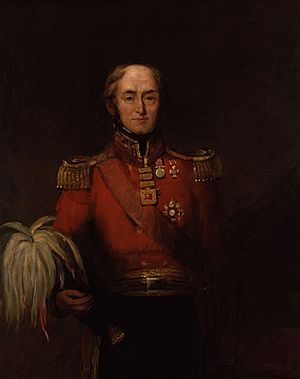Edward Barnes (British Army officer) facts for kids
Quick facts for kids
Sir Edward Barnes
|
|
|---|---|
 |
|
| 5th Governor of British Ceylon | |
| In office 18 January 1824 – 13 October 1831 |
|
| Preceded by | James Campbell (acting) |
| Succeeded by | John Wilson (acting) |
| Acting 1 February 1820 – 2 February 1822 |
|
| Preceded by | Robert Brownrigg |
| Succeeded by | Edward Paget |
| 12th General Officer Commanding, Ceylon | |
| In office 1820–? |
|
| Preceded by | Alexander Cosby Jackson |
| Succeeded by | James Campbell |
| Personal details | |
| Born | 28 October 1776 |
| Died | 19 March 1838 (aged 61) Walthamstow, Essex |
| Spouse | Maria Fawkes (m. 1823) |
| Children | Maria Anne (1825 – ?) Richard Hawksworth (1831–1904) |
| Awards | Knight Grand Cross of the Order of the Bath |
| Military service | |
| Allegiance | United Kingdom |
| Branch/service | British Army |
| Rank | Lieutenant General |
| Commands | General Officer Commanding, Ceylon British Indian Army |
| Battles/wars | Peninsular War |
Lieutenant General Sir Edward Barnes (born October 28, 1776, died March 19, 1838) was a British soldier. He became an important leader. He was also the governor of Ceylon.
Contents
Sir Edward Barnes's Army Career
Edward Barnes started his army career in 1792. He joined the 47th Regiment. He quickly moved up in rank. By 1807, he was a lieutenant-colonel. He fought in Martinique in 1809. He became a colonel in 1810.
Fighting in the Peninsular War
Later, he worked with Duke Wellington. This was during the Peninsular War. His good work helped him get promoted. As a major-general, he led soldiers. He fought in battles like Vitoria and the Pyrenees. He also fought at Nivelle, Nive, and Orthez. He received a special award called the Gold Cross.
The Battle of Waterloo
In 1815, Barnes was an adjutant-general. This role is like a chief of staff. He was hurt during the famous Battle of Waterloo. People called him "our fire eating adjutant general". He received several honors for his service. These included the KCB and awards from Austria and Russia.
Leadership in the Caribbean
In 1808, Barnes became the lieutenant-governor of Dominica. He served there until 1812. After that, he was named lieutenant-governor of Antigua in 1813. However, he did not take up that position.
Governor of Ceylon
In 1819, Edward Barnes began his work in Ceylon. Ceylon is now known as Sri Lanka. He was the acting governor from 1820 to 1822. Then, he became the official governor of Ceylon. He served from 1824 to 1831.
Key Achievements in Ceylon
As governor, Barnes oversaw important projects. He directed the building of a major military road. This road connected Colombo and Kandy. He also helped build many other roads. He organized the first count of the population. This is called a census. He also started growing coffee in Ceylon. He used methods from the West Indies. In 1831, he received another high honor. It was the GCB.
Later Career in India
From 1832 to 1833, Barnes was a commander in-chief in India. This was a very high military position.
Life After Ceylon
After returning to Britain, Barnes continued his career. In 1834, he became the Colonel of the 31st Regiment of Foot. He held this role until he passed away.
Political Life
He also tried to become a Member of Parliament (MP). He ran as a Conservative candidate. He finally became an MP for Sudbury in 1837. Sadly, he died the next year.
Legacy and Memorials
Barnes helped create the Army and Navy Club in London. A portrait of him was painted for Ceylon. A statue was also put up in Colombo. This statue was in front of the President's House. It was a very important landmark. Road distances in Ceylon were measured from this point.
Personal Life
Edward Barnes was born on October 28, 1776. His parents were John Barnes and Anne Parke.
Family
He married Maria Fawkes in 1823. They had two children. Their names were Maria Anne and Richard Hawksworth.
Death and Burial
Barnes died on March 19, 1838. He passed away at his home in Walthamstow, Essex. He is buried in the churchyard of St. Mary's Church, Walthamstow. A large monument marks his grave. It tells about his life and achievements.
See also
- Raj Bhavan, originally known as the Barnes' Court after Edward Barnes
Images for kids


